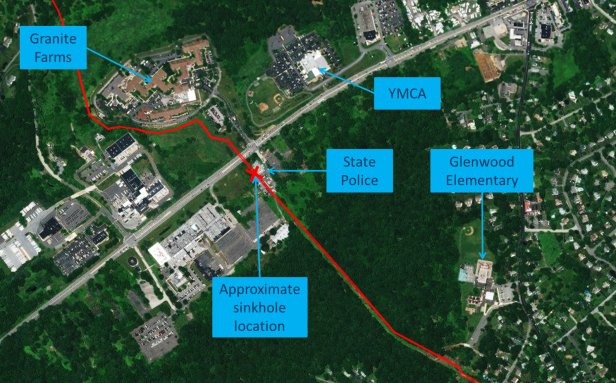
Yesterday (April 24, 2019) around noon a large sinkhole opened up in Middletown Township Delaware County along the route of the Dragonpipe (Mariner East pipeline system). In this case, it was in the right-of-way of the 12-inch “workaround” pipeline. Sunoco/ Energy Transfer is currently using this 1930s-era line to transport highly volatile liquids because Mariner East 2 could not be constructed on schedule as planned through Delaware County.
The sinkhole was near the Pennsylvania State Police barracks on Route 1, just west of Media, PA. Granite Farms Estates, a retirement living community, is directly across the street, less than 1000 feet away. The YMCA is equally close, and Glenwood Elementary School is within 2500 feet. All of these would be endangered by a pipeline rupture, and the State Police barracks could be destroyed by the ignition of even a minor leak.
Mariner East 2 and 2X, still under construction, are located in the same right-of-way and it seems likely that local construction triggered the sinkhole, but that has not been confirmed. Sunoco quickly began filling the 12’ X 12’ X 12’ hole with grout, so no inspection of the pipeline by regulators was possible.
What if there were a rupture? If the 12-inch pipeline (which is in full operation) had ruptured, high-pressure, highly-volatile liquids would have sprayed from the broken pipe, instantly turning to gas and forming a low-lying flammable cloud. Within about five minutes, the cloud would have engulfed a large area (the size of which would depend on how windy it was). But the police barracks would certainly have been in it, and Granite Farms, the YMCA, and Glenwood School are all close enough to have also been in the flammable cloud.
If the flammable cloud then ignited, it would produce a “flash fire,” killing everyone outdoors and many people indoors. That would be followed by a much smaller but more intense “jet fire” at the rupture location that would last for many hours before it would burn out.
Any evacuation plans? It is reasonable to ask how Sunoco and the local authorities dealt with this potential emergency. How quickly were authorities notified? Who made the decision not to call for evacuation of the people at risk, and on what basis was it made? Was Granite Farms notified? Glenwood Elementary? Did the State Police even know what was happening next to their building? Would an explosion at that site have crippled the ability of the State Police to deal with the emergency? Was Delaware County Emergency Services (which is supposed to handle dangerous incidents) notified?
Granite Farms is particularly vulnerable. As you can see from the aerial view, there is only one road into and out of this gated retirement community. Any evacuation effort would use that road, and any emergency responders (including fire fighters) would have to come in that way. But, in the case of a rupture and ignition located at Route 1, the jet fire would block anyone from using that road. The residents, many of them with limited mobility, would be isolated in the facility, parts of which might well be burning. What plans are there to deal with that situation?
This is exactly the kind of worst-case scenario that motivates me to continue fighting this pipeline. We may have dodged the bullet this time, but what about next time? This pipeline needs to be shut down until we know that it can be operated safety and that workable, realistic emergency plans are in place.

Excellent article George. Would love to see the answers to the questions you have asked here. These answers should be known – by all of us that have been put at risk.
LikeLike
How was it discovered? Did the media pick up on it?
On Thu, Apr 25, 2019 at 6:53 PM Dragonpipe Diary wrote:
> galex49 posted: ” Yesterday (April 24, 2019) around noon a large sinkhole > opened up in Middletown Township Delaware County along the route of the > Dragonpipe (Mariner East pipeline system). In this case, it was in the > right-of-way of the 12-inch “workaround” pipeline. Su” >
LikeLike
I’m not sure how it was discovered, but a 12-foot sinkhole next to a police barracks in a pipeline construction area won’t go unnoticed for long.
There are many reports about it in the local media. It’s primary season for some local races, and all the local politicians are now eager to tell the press all about their opposition.
LikeLike